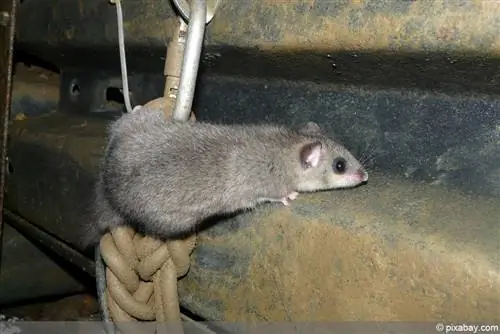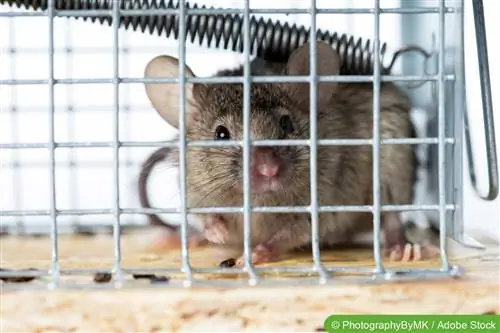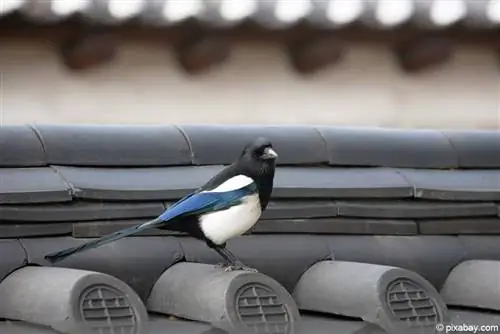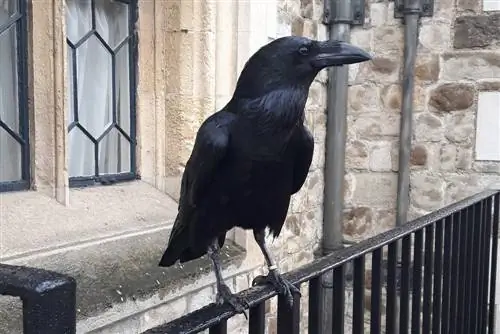- Author admin [email protected].
- Public 2023-12-17 03:39.
- Last modified 2025-01-24 12:45.
The dormouse is without a doubt one of the most annoying pests that you can catch in the house. It prefers to nest in the attic and often causes considerable damage there. But above all, it's annoying when the nocturnal animals keep you from sleeping. Unlike other pests, dormouse cannot be killed. You have to get rid of them differently.
dormouse
The dormouse is a nocturnal rodent that is the size of a mouse and similar in shape to a squirrel. It can live up to nine years and is easily able to climb walls and trees. In the wild, it prefers to sleep and nest in tree holes. In residential areas, attics and roof trusses seem to magically attract him. They offer plenty of protection during the day while he sleeps. It is also relatively warm there and the nearest food source is not far away. Its nocturnal migrations can cause considerable noise nuisance. In addition, feces and urine cause unpleasant odors. Once a dormice has chosen an attic as its habitat, it is very difficult to drive it out of it. By the way, it gets its name from the fact that it hibernates for around seven months.
Protection
Sdormouse is considered an endangered species in almost all Western European countries. They are therefore particularly protected and cannot simply be killed. In order to get rid of a single dormouse or a family of dormice, no poison or traps that could harm the animals should be used. This makes them very different from other pests in the house such as mice or rats. But above all, it makes combating it more difficult. The only legal and truly working method to get a dormouse out of the house is to capture it live and then move it to another habitat.
Home remedies
If you need to get rid of a dormouse, you can also look for tried and tested home remedies that can do this. If you ask around from friends or get information on the Internet, you will come across numerous tips in this regard. For example, it is recommended to temporarily fill the attic with loud music or generally with piercing sounds. Pungent smells should also help so that the animal runs away. The truth behind all of these tips, however, is that they are not really reliable and, above all, not sustainable. For example, a dormouse who has been chased away by loud music will almost certainly return as soon as it is quiet again. Incidentally, ultrasonic devices, such as those used to combat martens, do not seem to impress the dormouse.
Exterminator

When there is a pest infestation in the house or apartment, many people call the exterminator. As a professional, he knows exactly what he has to do to put an end to the unwelcome house guests. As a rule, poisons are used. Since the dormouse cannot be killed, even a professional pest controller can only help to a limited extent. He also has no choice but to catch the animal alive. But this requires patience and costs a lot of time - time that of course also has to be paid for. It is certainly not a bad idea to seek advice from an exterminator. But it's a good idea to carry out the actual catching action yourself.
Livetrap
The most important tool for catching a dormice is the so-called live trap. In contrast to a classic mouse or rat trap, the animal is not killed here, but simply locked up. If the trap is sprung, the trapped dormouse may experience significant stress reactions, but it will definitely survive. In principle, such a live trap is a cage that has a special mechanism. If the dormice triggers this mechanism by entering the cage, the trap is closed and the way out is reliably blocked. There are no special traps for dormice. It is therefore best to use live traps for mice or rats made of sturdy wire mesh. These are available in stores from ten euros.
Bait
Of course you also need a lure, i.e. a bait that gets the dormouse to enter the trap in the first place. Make no mistake: dormouse are intelligent animals that know their territory exactly. If there is suddenly a new part in it, it is initially viewed with great suspicion. It takes good arguments to get the animals to literally fall into the trap. A treat is just as much an argument. Fresh apple slices, for example, are very attractive to small rodents. A special mixture that you can easily make yourself has also proven to be useful. To do this you need the following ingredients:
- Peanut Butter
- raisins not soaked in alcohol
- fine or coarse oat flakes
- some water
The ingredients are mixed in a bowl with a clean spoon and the mixture is then formed into loose lumps. These clumps are then placed in the cage. Peanut butter in particular gives off a smell that makes dormouse's mouths water and attracts them.
Tip:
The bait should not be touched if possible, as the strange human smell could scare the animals away. It's best to use a spoon or fork.
Setup

Before setting up the trap or traps, it is a good idea to first locate where exactly the dormouse has nested. It also makes sense to determine whether it is just one animal or several animals. As a rule, dormice feel right at home in the attic. Based on traces of droppings and gnawing, it is relatively easy to determine whether an animal lives there. However, you won't see it during the day. If it is certain that a dormouse has colonized the attic, the trap can be set up. Depending on the size of the attic, several traps should be considered. Where exactly the trap is placed is relatively irrelevant. The smell of the bait will inevitably attract the dormouse.
Catch
Catching a dormouse can be compared to hunting. And that means above all: be patient. It can take a few days before one of the animals actually falls into the trap. Dormouse are not only smart, but also suspicious. They first have to get used to the fact that there is a new element in their territory. The bait may therefore need to be replaced once or twice. In any case, daily checks are mandatory. This is best done in the morning, as dormouse are nocturnal and sleep during the day.
Spend / Exposure
Once the dormouse has finally fallen into the trap and been caught, it must be moved to another habitat. It is not enough to release it in the garden or in a neighboring forest. The animals have an excellent sense of direction and would immediately start their journey back. The distance therefore plays a big role. A distance of around five kilometers is not a problem for the dormouse. One or two animals are said to have also managed a distance of 20 kilometers. It is therefore best to drive the caught rodent as far away as possible and then release it into the wild. To be on the safe side, obstacles such as a mountain or a river are recommended.
Prevention
If a dormouse chose an attic as its territory, then there were good reasons for it. These reasons can also encourage other dormouse to colonize the attic. To prevent this, you should take preventive measures to avoid bringing the next uninvited guest under your roof. Dormice usually get into the roof structure through the ventilation openings in the gable or through damaged roof parts. These entrances should therefore definitely be closed.
It is not recommended to seal the ventilation. However, it can, for example, be provided with a sturdy grille and thus prevent access.






